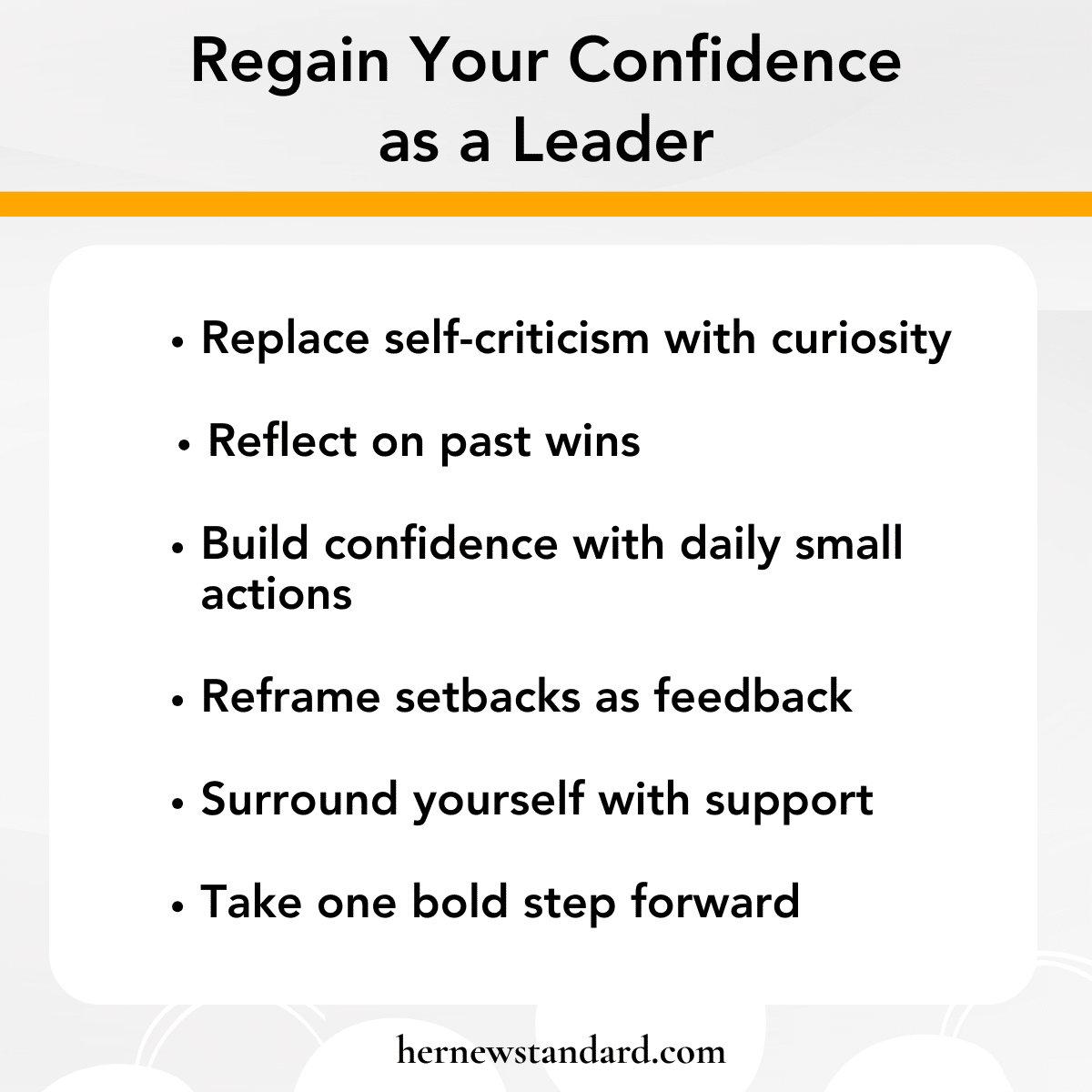Even the most seasoned leaders encounter moments that shake their confidence. It could be a project that falters, unexpected feedback, or a high-stakes decision that doesn’t land. A single setback can ripple through your confidence, cloud your judgment, and make you question your leadership identity. This is especially true for women, who often hold themselves to unrealistic standards then beat themselves up when they fall short of their own expectations.
And yet: this is also the precise point where transformation begins.
At Her New Standard, we coach high-achieving women leaders through inflection points like these every day. What we’ve learned is this: confidence isn’t a fixed trait. It’s a leadership practice that can be rebuilt and strengthened over time.
Here’s how to start rebuilding confidence after a setback. Instead of rushing to “bounce back,” choose to move forward with clear intention.

1. Replace Self-Criticism with Strategic Curiosity
Following a setback, many leaders fall into the trap of over-personalizing the event. The internal narrative quickly turns harsh: I should have seen this coming. I’m not cut out for this.
Instead, adopt a more strategic posture. Ask:
- What actually happened here?
- What was within my control and what wasn’t?
- What does this experience reveal about how I want to lead moving forward?
This reframing shifts you from judgment to clarity and creates the foundation for more resilient decision-making.
For deeper insights on how resilience fuels leadership growth, explore our article on resilient leadership.
2. Reconnect to Past Wins and the Capabilities Behind Them
When confidence takes a hit, it’s easy to forget your own track record. But your achievements haven’t disappeared, they’ve just been eclipsed temporarily.
Try this quick exercise, rooted in research-backed confidence-building practices:
Confidence Reflection Exercise
- Write down three times in the past year when you led with impact.
- Note the capabilities and decisions that made those wins possible.
- Ask yourself: How can I bring those same strengths into this new context?
This practice draws on psychologist Albert Bandura’s theory of self-efficacy, which shows that reflecting on past accomplishments strengthens your belief in your ability to succeed again. It’s a simple but powerful way to rebuild leadership confidence, starting with evidence from your own experience.
3. Build Confidence with Structured Exercises
According to recent search trends, more people are seeking “build confidence exercises” than ever before, and for good reason. The right habits help leaders move from intellectual awareness to embodied confidence.
Here are three practices we recommend:
The Win Journal
Capture one accomplishment each day, however small. Over time, this rewires your brain to track progress, not just problems.
The Brave Five
Commit to five bold actions per week. Speak up in a tense meeting. Ask for what you need. Say no when it matters. Each action affirms your capability.
The Confidence Reset
Before high-stakes moments, practice deep breathing, adopt an expansive posture, and reconnect to your intent. These small rituals prime your nervous system and executive presence.
These “confidence-building exercises” may seem simple but their compound effect is powerful.
4. Redefine the Narrative of the Setback
A setback isn’t a verdict, it’s feedback. A chance to refine, adapt, and lead more effectively.
Try re-authoring the moment:
- This experience revealed blind spots I can now address.
- This feedback is difficult AND valuable.
- I’m learning how to lead through complexity, not around it.
The most influential leaders aren’t immune to doubt. They’ve simply developed the tools to work through it.
Her New Standard’s co-founders explored this topic in their Forbes article on confidence for women leaders, underscoring that setbacks can be a springboard to more intentional leadership.
5. Surround Yourself with Strengtheners, Not Just Sounding Boards
Confidence rarely returns in isolation. Identify who helps you reconnect with your leadership identity. This might be a coach, a friend, or a former colleague who’s seen you at your best.
These relationships offer:
- Honest reflection
- Practical perspective
- Emotional reinforcement
It’s one of the reasons so many senior women leaders benefit from structured executive coaching after a professional setback. They’re not looking for platitudes. They’re looking for clarity, growth, and a path forward.
Learn more about how executive coaching helps high-achieving women regain confidence and expand their impact.
6. Take One Decisive Step Forward
Confidence is rekindled in motion. That doesn’t mean pushing past discomfort or bypassing reflection. It means choosing one meaningful action aligned with the leader you’re becoming.
Consider:
- Volunteering for a cross-functional project
- Clarifying your vision with your team
- Asking for feedback from a trusted mentor
Small, strategic actions reinforce your sense of agency. They also help you lead with renewed credibility, not because you have all the answers, but because you’re willing to evolve.
Confidence is Cyclical, Not Constant
The assumption that confident leaders are always self-assured is a myth. The most effective leaders we work with have learned to normalize moments of doubt and respond with reflection, structure, and support.
Confidence is something you regain, rebuild, and reinvest in over time.
At Her New Standard, we believe that setbacks aren’t a detour from your leadership path. They’re a proving ground.
Ready to turn this moment into a catalyst for growth?
Explore how Her New Standard’s leadership programs and executive coaching help high-achieving women regain confidence, strengthen resilience, and lead with renewed impact.
Frequently Asked Questions About Regaining Confidence as a Leader
Q: How do I rebuild my confidence after a leadership setback?
A: Start by reflecting on what happened without judgment. Reframe the experience as a learning opportunity, take ownership where needed, and focus on small wins that build momentum. Confidence comes from purposeful action over time.
Q: What should I do if I feel like I’m failing as a leader?
A: Feeling like you’re failing is often a sign you care deeply. Check in with your values, ask for honest feedback, and identify what’s actually going wrong versus what’s driven by self-doubt. Then take one clear step forward.
Q: Can you be a good leader without confidence?
A: Yes, especially if you lead with humility, purpose, and self-awareness. Confidence can grow as you act with integrity and make decisions aligned with your values and priorities. It’s not a prerequisite. It’s a result of courageous action.
Q: How can I boost my leadership confidence quickly?
A: Focus on micro-wins: prep thoroughly for one meeting, delegate one task well, or have one brave conversation. Then pause to reflect on what you accomplished. These small moments compound into real confidence faster than waiting for a big breakthrough.
Q: Is it normal to lose confidence as a leader?
A: 100%, even seasoned leaders hit moments of doubt, especially during high-stakes decisions, transitions, or after a mistake. What sets resilient leaders apart is how they respond to those dips, not whether they avoid them.
Q: When should I get help with my confidence as a leader?
A: If your confidence issues are impacting your team, your decision-making, or your ability to grow, it’s time to get support. A coach, mentor, or peer group can help you gain perspective and build a more resilient mindset.
Enjoyed this post? You might also like…




